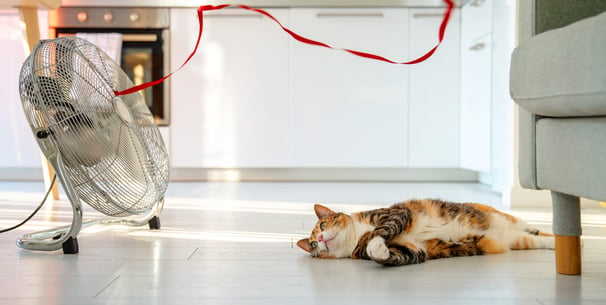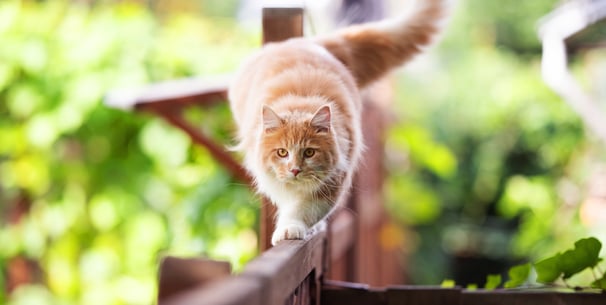The Sound of Contentment - Why Do Cats Purr? Explained
Index:



The sound of contentment: why cats purr, explained.
There's something universally soothing about a purring cat nestled in your lap. The gentle rumbles that rise and fall with the rhythm of their breath help to transform our living rooms into sanctuaries of peace. Have you ever found yourself pondering; why do cats purr?
Sure, we might facetiously claim it's their way of plotting world domination, but these enigmatic creatures hold a simpler truth within the hum of their vocal cords.
When cats make that distinctive sound, they are often doing a lot more than just voicing contentment. They might be healing, bonding or even communicating nuanced needs we're only beginning to understand.
Our furry friends have an arsenal of noises and quirky behaviours at their disposal, but none quite captures the heart like the purring cat.
Whether it's at the foot of our beds or weaving between our ankles, when cats will often purr, it's an invitation into their inner world.
Key takeaways
Understanding why cats purr reveals a complex behaviour serving multiple purposes beyond mere happiness.
The science behind a purring cat involves unique physiological processes, including the work of the vocal cords.
Cats will often purr during intimate moments of comfort, but they also use this sound to communicate various needs and emotions.
The comforting resonance of a cat’s purr may contribute to healing, reducing stress for both the cat and their human.
By closely observing when and why cats make this sound, pet owners can gain a deeper connection with their feline friends.
Realising that cats may purr in a variety of situations helps us foster a greater understanding of their internal states and well-being.
Whether a cat is expressing tranquillity or seeking attention, the purr when they’re happy remains an essential and cherished aspect of cat behaviour.
Why do cats purr?
When a cat is purring, it's often an intriguing showcase of their inner state and we are compelled to wonder, what exactly are they communicating?
Observing cats is a charming study into their rich emotional lives, as their purring serves multiple expressions beyond mere satisfaction.
Communicating needs and emotions: more than just contentment
Cats purr for a variety of reasons and understanding these can help deepen the bond we share with our feline companions. While cats purr to often indicate pleasure, cats purr when they're content, their purring also serves as a signal when they're hungry or in need of affection.
Cats purr to get your attention and communicate their needs.
Purring doesn’t necessarily mean your cat is happy; it can also be a sign of anxiety or discomfort.
Observing the circumstances in which a cat purrs can provide insights into their well-being.
The healing power of purring: putting the 'therapy' in 'cat'
Remarkably, purring is not only a means of communication but may have a nurturing effect on their physique.
Frequencies emitted during purring sessions have been linked to therapeutic benefits, suggesting a natural self-healing capability akin to treatments in human medicine.
Understanding the feline state of mind through purring patterns
Just as a smile doesn't always signify joy in humans, purring while sleeping or in seemingly innocuous moments may have varied implications in cats.
Purring can be a complex dialogue about their state of mind and needs, which behoves us as pet owners to respond with empathy and understanding.



Unravelling the mystery behind a cat's purr
The melodic purring of a cat is a sound that reverberates warmth and tranquillity throughout homes worldwide. This soothing symphony, though familiar, masks the incredibly intricate process that occurs beneath the soft fur.
While domestic cats purr with effortless grace, the mechanisms at play within their voice box involve an intricate interaction between neural oscillators and their laryngeal muscles.
The role of laryngeal muscles and neural oscillators
Central to a cat's ability to purr are the laryngeal muscles, which are orchestrated by signals originating from a neural oscillator in the brain.
It is this precise and rhythmic neural pulse that causes the laryngeal muscles surrounding the vocal cords and glottis to twitch, triggering the glottal cycle that produces the characteristic purring sound.
The action is similar to plucking a string on a musical instrument – a consistent, controlled vibration that resonates with a comforting regularity.
The distinction between purring and other feline vocalisations
Unlike other feline vocalisations that cater to long-distance broadcasts or immediate warnings, the purring sound is a more intimate gesture.
It is a vocal cord phenomenon that occurs within a domestic cat's larynx during both the inhalation and exhalation phases of breathing, allowing the purr to maintain a continuous cadence.
Wild cats and big cats, though they share the same evolutionary lineage, cater to different communicative strategies and environments.



From kittenhood to adulthood: the lifecycle of purring
Kittens are remarkable creatures that begin life with a notable absence of two primary senses – they are born blind and deaf. It's within these first few crucial days, in their otherwise silent and dark world, that kittens learn how to purr as a means of communication.
Mother cats attentively listen for these vocal cues, which signal the kittens’ locations and needs, such as during feeding time. This early purring serves as a pivotal communication lifeline that ensures the survival of these vulnerable newborns.
As kittens mature, their capacity to purr evolves. The reason kittens purr will shift from simply signalling hunger or comfort to their mother; it's a behaviour that becomes rooted in their social interactions.
Young cats purr when they're content, especially when they knead—a comforting action reminiscent of their nursing days. This innate kneading motion, often accompanied by purring, is universally recognised as an expression of satisfaction and joy among cats.
In the transition to adulthood, this fundamental aspect of feline behaviour retains its significance, providing a window into the emotional state of cats.
Purring is not just an automatic response; it's a deliberate action used by adult cats to communicate various feelings, from relaxation to affection, to their human companions or fellow cats.
It is remarkable how purring remains an integral way for cats to express themselves at different stages of their lives, demonstrating that the art of purring is one they never really outgrow.
Kittens purr to alert their mother of their well-being.
Purring aids in kittens' survival during the early stages of life.
Mother cats rely on purring as a way to bond with their offspring.
Adult cats continue to purr when they're content or to communicate needs.
Therefore, from the helplessness of their initial days to the assurance of their later years, cats purr for myriad reasons, all rooted in the basic instincts of survival, communication, and companionship.
The mystery behind why cats purr may never be entirely unravelled, but what is clear is the sheer importance of this trait from the moment kittens can purr up until they reach their senior days.



Conclusion
In the tapestry of feline behaviours, the act of purring stands out as a captivating enigma that continues to pique the curiosity of pet lovers and researchers.
An adult cat's purr resonates with a depth of meanings, with each vibration potentially signalling anything from supreme satisfaction to a desperate cry for attention.
The reasons a cat purrs are as varied as they are intriguing, intertwining with the science of their biology and the sensitivity of their unique personalities.
Quick answers to your questions...
Why do cats purr?
Cats purr for a variety of reasons that range from feeling content and happy to communicating needs such as hunger.
They may also purr in response to stress or discomfort, as a self-soothing mechanism, or even to communicate with their kittens or other cats.
Can all cats purr?
Almost all domestic cats can purr, and many wild cats too. However, not all big cats can purr.
For example, cats that roar, like lions and tigers, have a different anatomy in their voice box which makes them unable to produce the purring sound.
What role do laryngeal muscles play in a cat's purr?
Laryngeal muscles in the cat's voice box control the opening and closing of the space between the vocal cords—the glottis.
This controlled movement, directed by neural oscillators in the brain, creates the oscillating airflow that generates the purring sound.
At what stage of their life do kittens learn how to purr?
Kittens can purr when they're just a few days old. Born blind and deaf, they use purring to navigate their early days, signalling contentment to their mothers during nursing or when they're feeling comfortable and safe.
Can purring indicate that a cat is in pain or distress?
Yes, cats may purr when they are in pain or feeling anxious as a self-comforting action.
The act of purring can be a complex emotional expression and is not always a sign of contentment.
Is there any truth to the belief that purring has healing properties?
Research suggests that the low-frequency vibrations produced when a cat purrs may have healing properties that can aid in pain relief and bone and tissue regeneration.
This could explain why cats continue to purr even when they are not visibly happy or content.
Do cats purr for communication with humans?
Yes, cats often use purring to get the attention of their human companions, especially around feeding times or when they want affection. Purring can be a form of communication to express their needs and desires.
Why might a cat purr while it is sleeping?
Cats might purr while sleeping as a relaxation response. Just like humans might mumble or twitch in their sleep, a purring cat is likely deeply relaxed, and the purring is an extension of that feeling into their sleep state.
Or, perhaps you have a snoring cat, whose slumber is comfortably deep and lengthy. Sometimes a purr can indeed be mistaken for a mild snore.
How do cats produce a purr?
Cats produce a purr through a rhythmic, rapid twitching of the laryngeal muscles, which alternately dilate and constrict the glottis.
As the cat breathes, air touches the vibrating muscles, which produces the purring sound.
What different things might a cat’s purr communicate?
A cat's purr can communicate various needs or emotional states, including happiness, hunger, relief, or distress.
It can also be a way for a mother cat to bond with her kittens, or for cats to express contentment while interacting with humans or other cats.
Waggel Pet Insurance
Need more help? You're in luck if you're a Waggel Pet Insurance member. Along with our excellent coverage, we offer access to a 24/7 online vet to answer all your sticky questions, especially if you need grooming assistance.
Not a member? Why not get a quote now and cover your furry friend for a range of illnesses, all while enjoying our amazing perks and rewards.
Want more like this?
Get updates from us with helpful info, advice, answers to frequently asked questions and much more.
Index:
Related posts:
Get your quote
Along with our excellent coverage, we offer access to a 24/7 online vet to answer all your sticky questions.





